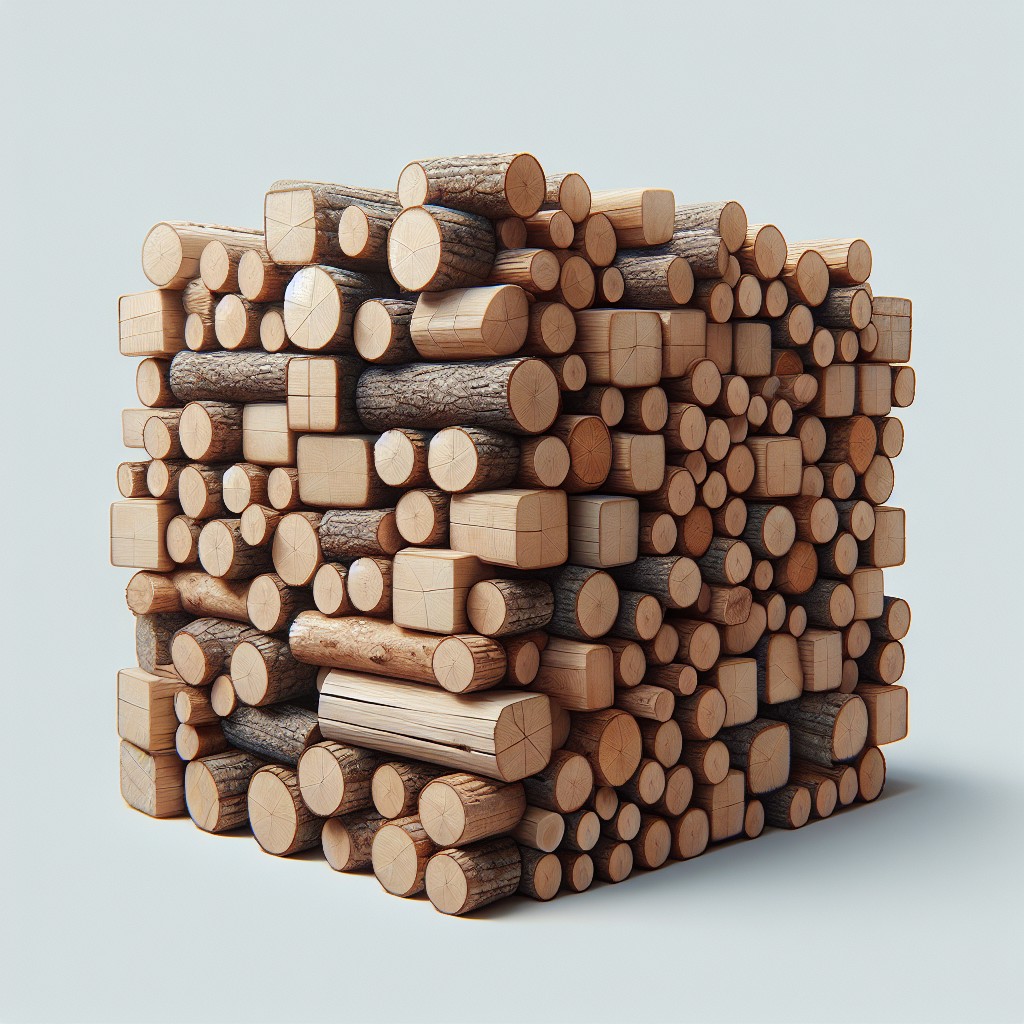Last updated on
Unraveling the mystery, we delve deep into understanding the size of a rick of wood because the precise knowledge can greatly impact your next camping trip or cozy fireside gathering.
Key takeaways:
- A rick or face cord of wood is typically 4 feet high by 8 feet long.
- The depth of a rick can vary between 16 to 18 inches.
- A rick is often one-third of a full cord of wood.
- The volume of a rick is around 42 cubic feet on average.
- Factors such as region and wood type can affect rick size and pricing.
What's Inside
Rick or Face Cord

Diving into the specifics, a rick or face cord references a wood pile typically measuring 4 feet high by 8 feet long. The depth, however, can vary, usually within the 16 to 18-inch range, which is the common length for firewood logs. This unit of measure is more ambiguous than a full cord, as the latter adheres to strict standards of 4 feet high by 4 feet wide by 8 feet long. Importantly, when dealing with a rick, the actual volume of wood you receive can vary based on the log length—shorter logs mean less wood overall. It’s a term you’ll often hear within the firewood market, and understanding its dimensions is crucial for accurately gauging the amount of firewood being discussed or sold.
Dimensions of a Rick of Wood

A rick often equates to a third or half of a full cord of wood. The standard measurements for a full cord are 4 feet high, 8 feet long, and a wood depth of 4 feet, making 128 cubic feet in total. Accordingly, a rick is typically measured as 4 feet high and 8 feet long, but the depth can vary between 16 to 18 inches.
While a full cord has a precise definition, the dimensions of a rick can fluctuate based on local customs, the seller, and how the wood is cut and stacked. The lack of a universal standard for a rick’s depth means the actual volume of wood you receive may differ. Always specify and agree upon the dimensions before purchasing to ensure you get the quantity of wood you expect. Remember to account for the space between logs when stacked; proper stacking can affect the volume of wood in a rick.
Variations By Region
Across different locales, the size of a rick can fluctuate, reflecting local practices and terminology. In some regions, a rick might be considered synonymous with a face cord, spanning about 8 feet long, 4 feet high, and wood pieces 16 inches in length, totaling roughly one-third of a full cord. However, variance arises due to the length of the firewood pieces; if wood is cut to 24 inches, the volume changes, affecting the rick’s size.
Transportation regulations can also influence rick size, as some areas have restrictions on vehicle load sizes. These laws can lead to smaller ricks that comply with transport standards. Additionally, the type of wood being sold—hardwoods versus softwoods—might result in different stacking practices, affecting the overall rick size.
Local vernacular is key. In certain places, you might find the term ‘rick‘ used interchangeably with ‘stack‘ or ‘pile,’ and the dimensions can be subject to individual sellers’ interpretations. Always communicate clearly with the vendor to understand the specific size of the rick in your region.
Full Cord Comparison
Understanding the volume of a rick of wood can be simpler when compared to a full cord. A full cord is a well-defined stack, measuring 4 feet high, 8 feet long, and 4 feet deep, totaling 128 cubic feet. This is the standard measurement used for firewood sales and provides a baseline for comparison.
- Typically, a rick or face cord is one-third of a full cord.
- It represents a stack of wood that is 4 feet high and 8 feet long but only as wide as the length of the cut logs, usually about 16 inches.
- This means the average volume of a rick is around 42 cubic feet, though this can vary.
- In contrast, a rick contains less than half the depth of a full cord, important when calculating how much to purchase.
Remembering these points ensures a better grasp of the amount of firewood in a rick, making buying decisions clearer.
How to Measure a Rick of Wood
Measuring a rick of wood ensures you get the right amount for your needs and helps verify you’re paying a fair price. You’ll need a tape measure and perhaps a calculator.
Start by measuring the length and height of the stacked wood. Most commonly, a rick measures 8 feet long and 4 feet high. However, the depth can vary, so measure that as well—standard depth is 16 inches.
After taking these measurements, calculate the total volume by multiplying all three dimensions (length x height x depth). Record your measurements in feet to keep consistency; you can convert inches to feet by dividing by 12.
The resulting figure gives you the cubic feet of wood in the rick, which you can compare against local standards or convert to a fraction of a full cord if necessary.
Remember, consistency in the way the wood is stacked—a tight, orderly stack versus a loose one—can significantly affect the volume, so use the same method when comparing different ricks.
Estimating Wood Quantity in a Rick
When you’re trying to estimate how much wood you’re getting in a rick, consider these pointers:
1. Typical measurements: A rick generally measures about 8 feet long, 4 feet high, and the width can vary but often is around 16 inches.
2. Wood type matters: Different types of wood have different densities and therefore some woods will provide more energy per rick.
3. Loose vs. tight stacking: The way the wood is stacked can affect the quantity. Loosely stacked wood means less wood per rick compared to tightly stacked wood.
4. Log length difference: Since a rick’s standard measurement depends on the log lengths, shorter logs can mean more individual pieces of wood because they fit more compactly into the given space.
Keep these factors in mind to make an informed estimate on the amount of firewood you’re purchasing or preparing.
Calculating the Volume of a Rick
To calculate the volume of a rick, first, consider the standard size, which typically measures 8 feet long by 4 feet high. The depth, however, can vary, usually ranging from 16 to 18 inches. Follow these steps to determine the volume:
- Measure the length, height, and depth of the stack in feet. If the depth is in inches, convert it to feet by dividing by 12.
- Multiply these three dimensions together (length x height x depth) to find the cubic footage.
- The result reflects the total volume of the stacked wood, including air space. Remember, since rick sizes are not uniform, the volume can vary.
As an example, using an 8-foot length, a 4-foot height, and a 1.5-foot depth (18 inches), the calculation would be:
8 x 4 x 1.5 = 48 cubic feet
This volume does not represent the actual amount of solid wood, as it includes gaps and spaces between logs. It’s a measure of the space the wood occupies when properly stacked.
Stacking a Rick of Wood
To achieve the best results while stacking a rick of wood, it’s important to use techniques ensuring durability and ease of access:
- Choose a dry, level area to prevent moisture retention and ensure stability.
- Place the largest pieces at the bottom to create a sturdy base.
- Layer the wood in alternating directions in each successive row for better air circulation.
- Leave small gaps between the logs to promote drying and reduce the potential for mold or pests.
- Stack the wood no more than 4 feet high to prevent toppling and facilitate easier reach for logs.
- If possible, cover the top of the stack with a tarp or woodshed roof while leaving the sides exposed to the air, which helps in seasoning the wood.
- Keep the stack away from buildings or trees to minimize fire hazards and further enhance air flow.
Following these tips will yield a neatly organized wood rick that maximizes longevity and readiness for use.
Pricing a Rick of Wood
Factors such as wood type, region, and seller affect the cost of a rick of wood. Hardwoods like oak or hickory generally command higher prices due to their higher BTU output and longer burn time compared to softwoods like pine.
Location plays a role too—the closer you are to a wood source, the less you’ll likely pay, particularly as transport costs are lower.
Market demand also influences pricing; in colder months, expect to pay a premium as demand for firewood spikes. Furthermore, if the wood is seasoned (dried), it will typically cost more than green (freshly cut) wood, due to the additional time and space required to dry out the wood properly.
When purchasing, be cautious of varying stack sizes and ask the seller for specifics. A standard rick should have a volume of around 128 cubic feet when stacked, but this can differ. Always inquire if a ‘rick’ matches the local definition to ensure fair pricing.
Seek quotes from multiple suppliers to find the best deal and consider the convenience of delivery and stacking services, which might be included or come at an additional charge. These services can affect the overall cost but offer convenience.
Remember, while the cost is important, don’t skimp on quality. Investing in good-quality, well-seasoned wood will provide more heat and a better burn, proving more cost-effective in the long run.
Factors Influencing the Cost of a Rick
The cost of a rick of wood is not a fixed amount; several factors play a part in determining the final price you pay. Species of wood is a primary determinant; hardwoods like oak, hickory, or maple tend to be more expensive due to their high energy content and longer burn time. In contrast, softer woods like pine burn faster and are typically cheaper.
Accessibility and location are also critical. If you reside in a wooded area where firewood is abundant, prices are generally lower. Conversely, in urban regions further from forests, transportation costs increase the price.
The season also affects the cost. Demand for firewood rises in winter, driving up prices, while summer may offer lower costs due to decreased demand.
It’s also worth considering the wood’s condition. Seasoned wood that’s ready to burn immediately will cost more than green wood, which contains moisture and requires time to dry.
Lastly, the current market competition and the presence of local suppliers can influence the price. More vendors typically mean more competitive rates.
Seasonal Variations in Rick Pricing
Prices for firewood, including ricks, often fluctuate with the seasons. In warmer months, demand dips and suppliers may lower prices to spur sales. Conversely, as temperatures drop and heating needs rise, the cost of a rick can increase due to higher demand.
It’s also worth considering the impact of wood harvesting seasons; freshly cut wood is more abundant in late winter and early spring, potentially reducing prices. To get the best deal, consider purchasing your firewood in late spring or summer when you might find lower prices and better availability.
Additionally, buying ahead of the cold season can also provide savings, as well as ensure you’re not left in the cold due to winter shortages. Keep in mind that some regions may have specific wood selling regulations affecting availability and pricing throughout the year.
Understanding Green Cords
When purchasing wood you might come across the term “green cords.” This refers to wood that has been recently cut and has not yet been seasoned, which means it still contains a high amount of moisture. The seasoning process typically takes about six months to a year and involves storing the wood in a dry place so it can dry out and be ready for efficient burning.
Here’s what you need to keep an eye on:
- Moisture Content: Green wood can have a moisture content of 50% or higher, making it harder to ignite and producing more smoke and creosote than seasoned wood.
- Weighs More: Due to its high moisture content, green wood is significantly heavier than seasoned wood.
- Longer to Season: If you buy a rick of green wood, ensure you have enough time to let it dry before you need to use it.
- Cheaper Option: Typically, green wood is less expensive than seasoned wood, which can be an important factor if you’re planning to buy in bulk and can afford to wait for it to dry.
- Storage Needs: Since green wood needs to season, you’ll need a dry area to store it and will need to stack it in such a way that it receives plenty of air circulation to aid in the drying process.
Understanding these key points will help inform your decision on whether green cords are the right option for your needs.
How Many Ricks of Firewood Do I Need?
Estimating your firewood needs hinges on several factors: the size of the space you’re heating, the frequency of use, and the duration of the cold season.
Typically, for occasional fires in a small fireplace or outdoor pit, one to two ricks should suffice for a season.
If you’re heating a small to medium-sized space regularly, consider four to six ricks.
However, for full-time heating of larger spaces throughout the winter, you may need upwards of eight ricks.
Remember, these estimates can vary with the efficiency of your wood-burning unit and the harshness of your local winters.
Always monitor your usage for a season to refine future estimates.
Firewood Delivery Options
When exploring firewood delivery options, consider the following:
1. Local Suppliers: Many local suppliers offer delivery services, often calculating the fee based on distance from their location. Make inquiries to find the best rate and delivery schedule.
2. Bulk Orders: Some suppliers may provide discounts for bulk purchases or repeat customers. Ask about any deals that could reduce costs.
3. Stacking Services: Delivery might include stacking, but often at an additional charge. Decide if the convenience is worth the extra expense.
4. Online Marketplaces: Websites and apps connect buyers with local firewood sellers who may offer delivery. Check ratings and reviews to ensure quality service.
5. Seasonal Timing: Demand for firewood peaks as the weather cools, making early ordering beneficial to ensure availability and potentially lower prices.
6. Access Considerations: Ensure the delivery area is accessible for the supplier’s vehicle and communicate any specific instructions for drop-off.
Selecting the right delivery option will ensure you receive your firewood conveniently and at a reasonable cost.
How to Order a Rick of Wood Online
Purchasing firewood in rick quantities has been simplified with the advent of online shopping. When ordering online, ensure that you select a reputable supplier who offers detailed descriptions of their wood, including species, seasoning, and whether it’s split or in rounds. Be clear about the volume you’re receiving, as rick sizes can vary.
It’s beneficial to check reviews from previous buyers to assess the quality of the wood and the reliability of the service. Most importantly, confirm delivery options and fees; some suppliers offer free delivery within a certain radius, while others may charge based on distance.
Specify the delivery location upfront, making sure there’s accessible, safe, and convenient space for the wood to be dropped off. Lastly, inquire about stacking services if you need assistance with organizing your new supply of firewood.
FAQ
How much wood is in a Rick?
A rick of wood typically contains between 275 to 325 pieces.
Can a rick of wood fit in a pickup?
In response to your query, a rick of wood, which is roughly half a cord, can feasibly fit in an 8-foot pickup truck bed.
Why is it called a rick of wood?
A "rick" of wood refers to both a regional unit of measurement, specifically a stack of firewood that is 4′ tall and 8′ long, and a method of stacking with crisscrossed ends, often known as "ricked" or "ricked up".
How much firewood is in a full cord?
A full cord of firewood amounts to a total volume of 128 cubic feet, configured typically as a stack that is 8 feet long, 4 feet high, and 4 feet wide.
What are the different types of wood that can be in a rick?
A rick of wood can contain various types such as oak, maple, birch, pine, fir, spruce, poplar, and cedar.
How long does it take to manually split a rick of wood?
Manually splitting a rick of wood can take approximately 3-6 hours depending on the wood’s hardness and the splitter’s experience and physical condition.
What’s the average cost of a rick of wood?
The average cost of a rick of wood ranges from $60 to $100.




